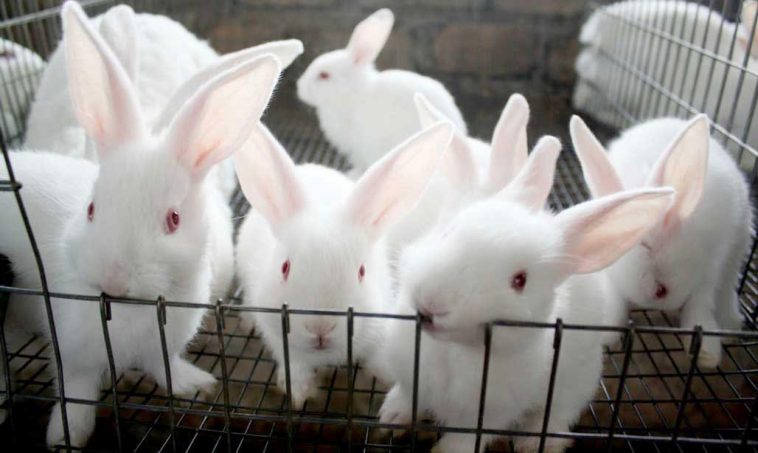Rabbit farming can be an alternative farming opportunity for a beginner farmer or someone with limited resources. According to Mike Daka, a rabbit farmer and interim President of the Rabbit Farmers Association of Zambia, the demand for rabbit meat in the country is growing.
He told the Xinhaunet News Agency* that the Association was formed to encourage and assist farmers to meet the local demand, and even export to the Democratic Republic of the Congo.
The rabbit species mostly used for farming are the New Zealand White and California White breeds, as they are easy to breed and grow fast, unlike local breeds.
Backyard rabbit farming can be a fantastic concept for producing healthy meat while also providing an additional source of cash for the family, with little effort on the part of the farmer. They can be raised in a convenient and cost-effective manner in a domestic setting.
It is simple to care for the animals, and even youngsters can participate in the farming operations, which include everything from breeding to fryer (rabbit prepared for meat) production. To get started, only a fundamental understanding of rabbit husbandry is required.
Rabbits reared by using techniques that are tailored to specific environments can significantly improve the diet of many of the most vulnerable rural families, while also providing a reliable source of income on a consistent basis.
Rabbit meat is an alternative healthy white meat which has less cholesterol, increased levels of protein and Vitamin B12. People who are sensitive to high sodium level diets could benefit from the meat which is low in sodium and has weight reduction properties.
A small backyard rabbitry may consist of around four breeding females (does) and one breeding male (buck), with the ability to produce two fryers per week throughout the year. Nutritional and wholesome meat for the family, pleasurable occupational activity, rich manure for the garden, and possibly additional household income can all be provided by the unit.

Besides the growing demand for rabbit meat as a healthy white meat alternative, the increasing popularity of rabbit farming can be contributed to the following:
They take up very little space
Rabbits make excellent backyard animals because they are quiet, odourless, and docile. Small farmers, whether they own land or not, will find that backyard rabbitries are particularly well suited to their needs.
They are inexpensive to keep
They can be raised in a convenient and cost-effective manner in a domestic setting. Even though rabbits are mostly noted for their profusion of offspring, they are also herbivores capable of efficiently converting grass into food.
They have a varied diet
The entire purpose of meat production is to transform plant proteins that are of little or no nutritional benefit to humans into high-value animal proteins. Rabbits are easy to feed because they consume a wide variety of foods, some of which are weeds that grow in the wild. A small rabbitry can be maintained in the backyard using kitchen/vegetable waste, grasses, tree leaves, and other natural materials.
They produce meat with high-quality protein
Rabbits have the ability to convert up to 20% of the proteins they consume into edible meat when raised in efficient production systems. Comparable percentages for other species range from 22 to 23 percent for broiler chickens, 16 to 18 percent for pigs, and 8 to 12 percent for beef.
Rabbits grow quickly, reaching a body weight of 1,5 to 1,8 kg in 12 to 14 weeks (depending on species) and providing nutrient-dense and flavourful meat.
They produce many offspring in a short time span
During the course of a year, a doe can give birth (kindles) up to seven times, resulting in between seven and eighteen kits/kittens (baby rabbits) each time, for a total of up to 72 kits in one year (depending on species).
Rabbits can be sold for a profit
A small-animal husbandry operation can be a very profitable venture for both land-owning and landless small farmers; it can provide employment opportunities for women, children, and the handicapped (those from the least privileged social strata), generate substantial income, and contribute to the improvement of the family’s nutritional standards.
References
The information provided in this article is credited to: The National Department of Agriculture in South Africa in cooperation with JA Erasmus at the Glen Agricultural Development Institute. For more information visit www.daff.gov.za or send an e-mail to DPP@nda.agric.za.
*http://www.xinhuanet.com/english/africa/2021-07/09/c_1310052234.htm
Nurturing the roots of change in rural Kenya in cooperation with Bonnie Ami Holt at the Mitahato Education and Development Fund. For more information visit www.mitahatoedf.com/ or contact them on +254-728-082887.
Dutta, P., Singh, R.K., Dhali, A. & Rajkhowa, C. (2009). BACKYARD RABBIT FARMING. 10.13140/RG.2.1.1742.5440/1. Further discussions, stats, and author profiles for this publication at: https://www.researchgate.net/publication/273886912








